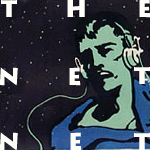The scene. It's everywhere you want to be: the fabulous clothes, slammin'
tunes playing till the wee hours every night, a quasi-religious community
of like-minded music fans, artists, and producers. Every movement in art,
it seems, flowers from the soil of a self-described subculture, and
electronic music is no different. Or is it?
The biggest influences in electronica these days -- dub, drum 'n' bass, and
hip-hop -- all have their identifiable roots in a specific community: the
Kingston dancehalls where reggae DJs invented the vast echospace of dub,
the black English clubs where reggae was reinvented by techno producers as
the anchorage of the early drum 'n' bass sound, the Bronx streetcorners
that spawned hip-hop's ethic of boom, rhyme, and piracy. Like most new
musical genres, these forms started underground, then spread outward in
waves as commercial popularizers came onto the scene and "outsiders"
adopted elements for their own purposes.
Techno and its kissing cousin, house, are the most visible "scenes" in
electronic music at the moment (and have been so since 1989, give or take a
couple of years). Big pants, flashy black-and-white sneakers, and stripy
athletic shirts are de rigueur on the techno/rave scene; house fans follow
similar lines but add a massive dose of feathery, sequined club kitsch to
the mix. Both scenes, particularly in their home turf of the U.K., are
arranged around the socialized use of drugs, with Ecstasy being the
chemical of choice for most. And many ravers adopt a fuzzy, new-agey moral
code: "PLUR," for "Peace, Love, Unity, Respect," which is integrated into
the whole-lifestyle approach to raving as a necessary brake on the human
tendency to bloody-mindedness and poor behavior.
Musicians, too, attach themselves to the scene as a way of taking their
aesthetic bearings. The hip-hop ideal of "keeping it real" originally
signified the necessary connection of one's own rough street experiences
with the music, but the ethic has percolated throughout electronic music
circles and now means (to many) a sort of artistic yardstick. Here, to
"keep it real" means to stay within the implicit boundaries of a scene's
style: the "real" is whatever conforms to standards of tempo, sample
sources, bass sound, and so on. Fans use the same ruler -- the "real" must
also, importantly, be untainted by commercialism, or at least produced with
noncommercial intentions (whatever the monetary side-effects). A commercial
drum 'n' bass track, say, is one that aspires to break the circle of
scenester cool by appealing to the vague, unenlightened, non-club-going
masses (hence the near-universal contempt for pop junglists like Everything
But the Girl on the part of confirmed drum 'n 'bass "headz").
A fringe of avant-garde "invaders" is always circulating around the edges
of a music scene, and this is where the world of electronica has been
particularly notable. Progressive producers like the Aphex Twin,
Squarepusher, Luke Vibert (aka Plug, Wagon Christ) and Mike Paradinas (aka
µ-Ziq, Gary Moscheles, and Jake Slazenger)
steal shamelessly from the effects bin of drum 'n' bass, creating a
living-room listening genre sometimes derided as "weirdstep." Scenesters
complain that weirdstep sucks all the funk out of the groove, that it's a
musical dilettante's idle diversion, that it doesn't work on the dancefloor.
But the weirdstep practictioners and dedicated fusioneers are mining vast
record collections for any rhythm, any bassline, any drum pattern that
could be remixed into a semi-boogie, ear-opening track, while the "strict"
junglists seem to rely almost exclusively on a single breakbeat (the famous
"Amen" break, possibly the only single rhythm line to spawn an entire genre
of music). Innovation comes from distance. A critically detached
perspective is necessary in order to rearrange the conventions of a style
against themselves, to make the "hip" assumptions of scenedom work against
-- and for -- the "strict" pattern
Of course, the avant-gardists align themselves into a sort of scene,
creating a tricky paradox. How can you have a collective of artists whose
whole aim is to undermine the idea of a collective? This seems particularly
true in the case of the Cologne/Dusseldorf orbit of artists like Scanner,
Main, Oval, Mouse on Mars, Microstoria, and others, who blend seamlessly
the twin knives of technological obsession and semi-radical cultural
critique. But the human will to gather and form exclusive societies, it
seems, is far stronger than the critical perspective that would rather see
scenes wither into irrelevance. Scenes carry with them a certain
eschatology: act in such-and-so a way, listen to this sort of music in that
way, and you will be blessed with grace. The slippery evasions of those
hipsters who try to elude scenedom -- often buttered with a thick slab of
postmodern theory, a la DJ Spooky -- merely show, as Nietzsche knew, how
difficult it is to live without gods.
PICK OF THE MONTH
Fatboy Slim: Better Living Through Chemistry (Astralwerks).
Don't miss this orgy of extra-super-dance-enhanced funky, jazzy, loungey
club tunes. The 303 bass machine is set to 11 the whole way -- beware of
structural damage if you play this one loud. Ex-Housemartins bass player
Norman Cook makes the switch from analog to digital with complete ease --
his experience as a bass player gives him a better sense of funk and groove
than most techno producers. The CD lines up an insanely fun mix of just
about every dance genre nameable. It's candy, but it's good for you, too.
Shake that booty!



